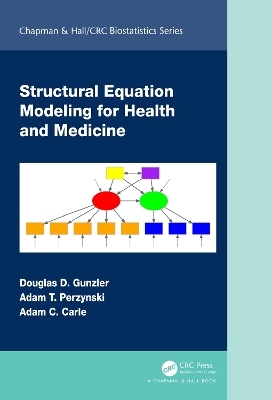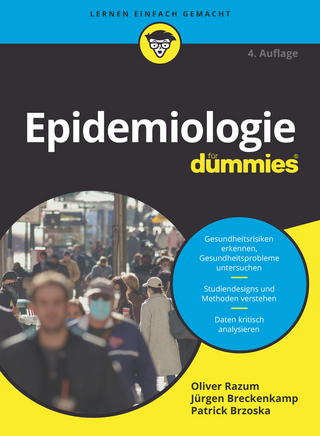
Structural Equation Modeling for Health and Medicine
CRC Press (Verlag)
978-1-138-57425-0 (ISBN)
Structural equation modeling (SEM) is a very general and flexible multivariate technique that allows relationships among variables to be examined. The roots of SEM are in the social sciences. In writing this textbook, the authors look to make SEM accessible to a wider audience of researchers across many disciplines, addressing issues unique to health and medicine.
SEM is often used in practice to model and test hypothesized causal relationships among observed and latent (unobserved) variables, including in analysis across time and groups. It can be viewed as the merging of a conceptual model, path diagram, confirmatory factor analysis, and path analysis. In this textbook the authors also discuss techniques, such as mixture modeling, that expand the capacity of SEM using a combination of both continuous and categorical latent variables.
Features:
Basic, intermediate, and advanced SEM topics
Detailed applications, particularly relevant for health and medical scientists
Topics and examples that are pertinent to both new and experienced SEM researchers
Substantive issues in health and medicine in the context of SEM
Both methodological and applied examples
Numerous figures and diagrams to illustrate the examples
As SEM experts situated among clinicians and multidisciplinary researchers in medical settings, the authors provide a broad, current, on the ground understanding of the issues faced by clinical and health services researchers and decision scientists. This book gives health and medical researchers the tools to apply SEM approaches to study complex relationships between clinical measurements, individual and community-level characteristics, and patient-reported scales.
Dr. Douglas Gunzler is a tenured Associate Professor of Medicine and Population and Quantitative Health Sciences in the Population Health Research Institute at the Center for Health Care Research and Policy, MetroHealth at Case Western Reserve University. He is a Biostatistician with specialties in structural equation modeling (SEM) and longitudinal data analysis. His research interests lie in the areas of mediation analysis, factor analysis, mixture modeling, psychometrics, age-period-cohort analysis and their application to both clinical trials and observational studies in health and medicine. In his research, he is using SEM for analysis of overlapping symptoms in co-occurring conditions. Dr. Gunzler received his PhD from the Department of Biostatistics & Computational Biology at the University of Rochester in 2011. Dr. Adam Perzynski is a tenured Associate Professor of Medicine and Sociology in the Center for Health Care Research and Policy at MetroHealth and Case Western Reserve University. He is also the Founding Director of the Patient Centered Media Lab. His doctoral degree is in sociology and his current research interests include: novel strategies to eliminate health disparities, outcomes measurement over the life course and research methods. His methodologic expertise spans the continuum from focus groups and ethnography to psychometrics and structural equation modeling. His publications span many disciplines and stand out against the backdrop of a career long effort to infuse the study of biomedical scientific problems with the knowledge, theories and methods of social science. Dr. Adam C. Carle is a clinically and quantitatively trained investigator. He is nationally recognized as an expert in pediatric patient reported outcomes and measurement. He uses structural equation models (SEM), multilevel models (MLM), and contemporary test theory (e.g., item response theory: IRT) to advance the methodological science used to measure health and health related outcomes from the family and child’s perspective, investigate the correlates of children and their families’ well-being, and investigate and eliminate health disparities. Additionally, his work seeks to better understand individual and contextual variables’ influences on health and health disparities at individual, local, system, state, and national levels. He is a PI, Co-PI, or Co-I on numerous Federal grants and has served as a reviewer for Federal granting agencies and national foundations. He has published over 80 peer reviewed manuscripts. Most important, he thinks his family is amazing (including the dogs and sheep).
Part I Introduction to Concepts and Principles of Structural Equation Modeling for Health and Medical Research
1. Introduction and Brief History of Structural Equation Modeling for Health and Medical Research
2. Vocabulary, Concepts and Usages of Structural Equation Modeling
Part II Theory of Structural Equation Modeling
3 The Form of Structural Equation Models
4 Model Estimation and Evaluation
5 Model Identifiability and Equivalence
Part III Applications and Examples of Structural Equation Modeling for Health and Medical Research
6 Choosing Among Competing Specifications
7 Measurement Models for Patient-Reported Outcomes and Other Health-related Outcomes
8 Exploratory Factor Analysis
9 Mediation and Moderation
10 Measurement Bias, Multiple Indicator Multiple Cause Modeling and Multiple Group Modeling
11 Latent Class Analysis
12 Latent Profile Analysis
13 Structural Equation Modeling with Longitudinal Data
14 Growth Mixture Modeling
15 Special Topics
| Erscheinungsdatum | 12.04.2021 |
|---|---|
| Reihe/Serie | Chapman & Hall/CRC Biostatistics Series |
| Zusatzinfo | 30 Tables, black and white; 86 Line drawings, black and white; 86 Illustrations, black and white |
| Verlagsort | London |
| Sprache | englisch |
| Maße | 178 x 254 mm |
| Gewicht | 725 g |
| Themenwelt | Geisteswissenschaften ► Psychologie |
| Mathematik / Informatik ► Mathematik | |
| Studium ► Querschnittsbereiche ► Epidemiologie / Med. Biometrie | |
| ISBN-10 | 1-138-57425-2 / 1138574252 |
| ISBN-13 | 978-1-138-57425-0 / 9781138574250 |
| Zustand | Neuware |
| Informationen gemäß Produktsicherheitsverordnung (GPSR) | |
| Haben Sie eine Frage zum Produkt? |
aus dem Bereich


